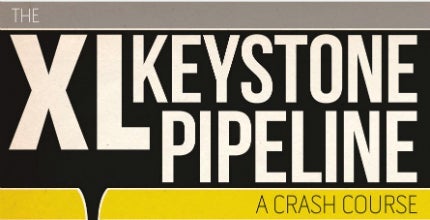
For a quick intro to Keystone XL click here or on the image above to be taken to Keystone XL pipeline infographic – a crash course.
The story begins in Canada
Thousands of miles of pipeline already crosses American soil, transporting thousands of gallons of oil daily, but it is the prospect of yet another pipeline that has the American public, environmentalists and industry riled up.
TransCanada’s proposed $5.3bn pipeline project, Keystone XL, which will transport tarsands crude oil, or bitumen, along an 835 mile route from Alberta, Canada, to Steele City, Nebraska, in the US, has become a partisan issue in America, with the petroleum industry lobbying strongly for it and environmentalists lobbying vehemently against it.
Related project
Keystone XL Crude Oil Pipeline, Canada
How well do you really know your competitors?
Access the most comprehensive Company Profiles on the market, powered by GlobalData. Save hours of research. Gain competitive edge.

Thank you!
Your download email will arrive shortly
Not ready to buy yet? Download a free sample
We are confident about the unique quality of our Company Profiles. However, we want you to make the most beneficial decision for your business, so we offer a free sample that you can download by submitting the below form
By GlobalDataAs the period for public consultation ended on Monday 22nd of April, the debate raged on, fuelled by a letter issued by the Environmental Protection Agency on the same day, which publicly denounced, for a second time, the US State Department’s favourable environmental review of the pipeline back in March.
Those in favour of the pipeline, which TransCanada first sought permission for back in 2008, believe it will create badly needed jobs and foster energy independence, insisting that the pipeline should in fact be viewed as a welcome gift because TransCanada have agreed to foot the bill. Critics, however, point to its disputed environmental review, its inevitable contribution to climate change, possible oil spills and the fact that America would be committing to a future of what they call ‘dirty oil’.
The government, meanwhile, is undecided. In January 2012 the US State Department rejected the phase four plans of Keystone XL, which crosses the US / Canada border, because of environmental concerns. The following May the department again rejected revised plans submitted by TransCanada, because they pass over the Ogallala Aquifer, a source of ground water for 20% of agriculture in the US. US President Barack Obama has promised to make a decision on the pipeline sometime in 2013, and with only 90 days to run until a period of national interest consultation will pass, a decision is expected in the early summer.
As Congress weighs up its options, what is the truth of the advantages and disadvantages of the Keystone XL Pipeline beyond all the propaganda?
Temporary vs. permanent jobs
The promise of much needed jobs in America’s recovering economy has been a key crutch of the pro-pipeline party’s argument. Though the number tends to change depending on who you speak to, on TransCanada’s website they state that construction of the pipeline will require 9,000 skilled American workers, and that an additional estimated 7,000 US jobs are being supported in manufacturing steel and other things needed for the pipeline.
"There is no reason why the Whitehouse should turn down thousands of good paying construction jobs," Sabrina Fang from the American Petroleum Institute says.
However, some have questioned the longevity of these jobs and their real, long term value. Being construction contracts the jobs would inevitably be short-term – two years possibly – something that the petroleum industry agrees with. So how many jobs will be left when the project is complete?
"According to the state’s report the project will provide 35 permanent jobs across the entire stretch of the pipeline, so you are talking about fewer jobs than your average restaurant. It’s not a job creator in the long term," says Peter LaFontaine, from the National Wildlife Federation.
However, he stresses the Institute are not against new jobs for people. But for those in favour of the pipeline, LaFontaine’s argument doesn’t stick.
"Well the bottom line is, all construction jobs are temporary," says Fang. "To deny these skilled Americans a good project with a good pay check over the next couple of years doesn’t make any sense."
If jobs were the only consideration in the approval of Keystone XL, Fang would be right, but it isn’t; and there is always the argument that an oil spill from the pipeline could indeed endanger local jobs, such as farming.
Climate change – avoidable or inevitable contributor?
Extracting Canadian tarsands requires more energy than pumping crude out of a well because the oil is mixed in with sand and must be separated. Environmentalists say this higher energy use leads to greater greenhouse gas emissions, a view supported by the EPA in its latest letter, which says the project will increase emissions by "18.7 million metric tons (20 million tons) C02 … per year when compared to an equal amount of US average crudes."
Fang says that this is not an argument about climate change.
"If you look at the State Department’s climate report Canadians are going to produce this energy whether Keystone is produced or not."
However, since her comment, the EPA in the same letter label the State Department’s review as ‘insufficient’ and says it finds environmental objections in the review, which was issued in March.
The report also states that the review made assumptions, like Fang, pointing to the belief that tarsands will find there way to market regardless of Keystone. It adds that, due to market considerations, this isn’t necessarily a concrete statement.
The report reads: "This analysis should include further investigation of rail capacity and costs, recognizing the potential for much higher per barrel rail shipment costs than presented in the DSEIS".
Since the letter was issued, environmentalists have also pointed out that the March review fundamentally violated the nation’s core environmental law by making this assumption, a statement which some consider as a litigation warning should the state department continue to insist the pipeline doesn’t pose a climate change threat.
LaFontaine believes the pipeline is a "climate catastrophe in the making" and that "anyone who says it wouldn’t be a key driver in development of tarsands really isn’t looking at the reality on the ground." So far his view is the one being supported by the EPA.
What is the public’s opinion?
During the ongoing Keystone debate it has been difficult to determine which argument is winning the public over.
For example, a website against climate change, 350.org, obtained one million comments against the pipeline. However, Nik Nanos, a public policy scholar at the Woodrow Wilson International Center for Scholars in Washington, told Yahoo News that he surveyed 1,007 Americans between March and April 2013 and 1,013 Canadians between April 6th and April 9th 2013, and found that 74% of Americans and 68 % of Canadians that have heard about Keystone either support it, or somewhat support their respective governments approving it.
"I think people are really just mind boggled as to why this pipeline hasn’t been approved. The fact of the matter is the public strongly support this pipeline," Fang says.
However, Ross Hammond, from environmental group Friends of the Earth, believes a lot of this support is drummed up by millions being spent on a "slick lobbying and public relations campaign", but "when you tell people how few jobs Keystone will create and the risks to the climate and communities that support drops significantly."
LaFontaine also insists that many conservative rural landowners – people you might assume to be for the pipeline – are against it because of its possible environmental impact, and because they don’t want to deal with TransCanada.
Industry, however, is certainly in favour. On the TransCanada website you can find around 100 published letters from industry bodies, from the US Chamber of Commerce to the Hispanic Alliance of Prosperity, dated from 2009 to 2011, all declaring their support for the project.
Tarsand spills – worth the risk?
With any pipeline there is a risk of a spill; and as the current proposed route for Keystone XL runs over an aquifer, a spill could be particularly devastating.
"We feel that we’re confident this pipeline will operate safely and we don’t want any spills in this country," says Fang, but she concedes that it’s always possible a spill could happen, adding also that TransCanada has added 57 additional safety requirements outside of what is required to avoid a spill situation.
LaFontaine, however, believes pipes transporting this type of heavy oil appear to be more prone to spills.
What he is referring to is several recent spills, such as the one in Arkansas in April, where an ExxonMobil pipeline transporting tarsands crude from Canada burst evacuating 22 people from their homes and devastating the local area. In Michigan three years ago, Enbridge Energy Partners’ pipeline gushed 20,000 barrels of heavy Canadian crude into the Kalamazoo River system, resulting in the largest onshore oil spill in American history. Its continuing clean up is estimated to have cost more than $800m already.
Spills aren’t good for anybody – oil companies, the environment or local people – and predicting them is impossible, but if TransCanada’s spill contingency plans aren’t up to scratch it could further delay the pipeline. Environmentalists on Monday demanded to see and be able to examine TransCanada’s detailed spill clean up plans.
Clean energy vs. energy security
For Keystone XL supporters, one of the attractive advantages of the pipeline is that it will provide energy security for America if approved. It would also reduce American dependence, from what pipeline supporters call "unstable" sources, such as Venezuela and the Middle East, by up to 40%, according to TransCanada.
Fang says: "There is data that shows North America could be 100% energy self efficient in less than a dozen years with more Canadian oil sands, more biofuels and more domestic production, so Canada is a vital part in making this country more secure."
Although there is no doubt energy security is an important goal for everyone in America, LaFontaine believes "dirty" Canadian tarsands is not the best place to get it from.
"By constructing this pipeline you are furthering a system that is reliant upon fossil fuels and what we need to be doing is transitioning to an economy that is growing based on renewable energy," he says.
"Too many members of Congress are beholden to the oil industry and their enormous campaign donations, and this has really stalled progress on the clean energy projects we need to move forward with. Sometimes Congress seems to forget they work for their constituents, not for TransCanada and the American Petroleum Institute." he adds.
However, Fang, who says the API also supports renewable energy, believes this view is unrealistic.
She says: "The fact is fossil fuels are the main part of our energy infrastructure so we can’t live without it. The question is, where you going to get it?"
No doubt tarsands will provide a reliable – but not renewable – source of fossil fuels, but it won’t necessarily make this source any cheaper than oil form Venezuela or anywhere else, as oil and energy are global markets and prices are set by global supply and demand – the same factors set the price of oil, regardless of whether it comes from Venezuela or Canada, with the only fluctuations in price coming from the quality of the oil.
The final decision
There is only one issue critics and supporters agree on and that is it that the debate has unnecessarily become a partisan issue, a ‘political football’ as Fang says, and an opportunity for those who wanted "to see the president put in a tough position" as LaFontaine suggests.
And the pressure on the president isn’t about to ease up any time soon. The 90 day national interest timeframe has begun, but even when it’s passed the latest EPA critique suggests it could be longer than early summer before a decision is made.
Asked to predict which way the President will turn, Fang says: "If I could make a prediction, if he sides with science and the public and the American people and jobs and energy security, I’d say he’d approve it."
Whereas, LaFontaine says: "I think it is 50/50. It really comes down to what president Obama and Secretary of State John Kerry decide is more important to protect – if it’s wildlife, public health, transparent government, then I think they will say no."
This just goes to show, that right now, what decision will be made really is anyone’s guess.
Related content
Keystone XL Pipeline infographic – a crash course
TransCanada’s proposed 835 mile Keystone XL Pipeline has divided a nation, but how do the facts stack up?
Keystone XL Crude Oil Pipeline, Hardisty, Alberta, Canada
Keystone XL Pipeline is a new 1,897km-long crude oil pipeline being planned by TransCanada.






